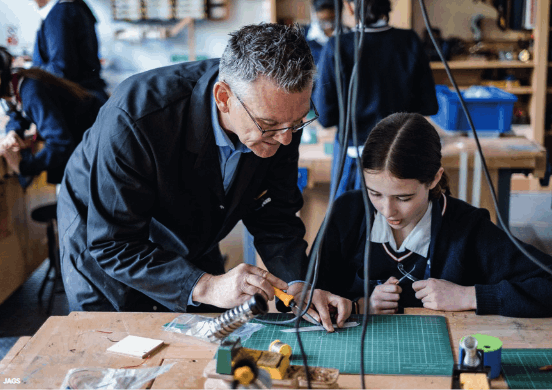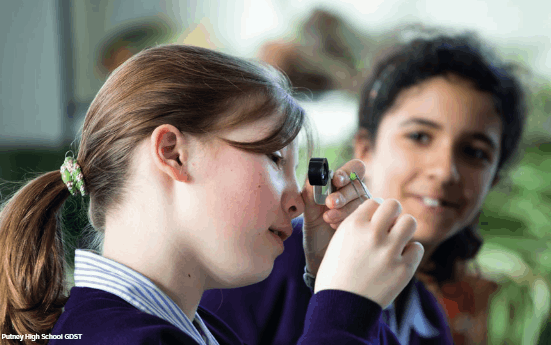Menu
Problem solving is a key skill needed for employees if they are to succeed in the future world of work, and schools need to wake up to the demand from employers, which some already have, finds Gillian Upton
The acceptance by educationalists that academic prowess alone doesn’t make for an all-rounded child needed for today’s workplace is rippling through curriculums throughout the country. The pandemic forced a new focus on mental health, wellbeing and pastoral care, and then STEM – science, technology, engineering and mathematics – gave way to STEAM – adding visual arts, language arts and physical arts – as a way of using those softer skills to solve problems.
Industry observers believe schools now need to teach children how to think. Schools have traditionally taught critical thinking which is based on debating and argument and usually driven through RS and PHSE, but the next evolution is to teach lateral thinking, to give children the skills to think creatively, in multiple perspectives, and to solve problems more effectively and collaboratively.
One of the key findings from the World Economic Forum’s 2023 Future of Jobs Report, published in May this year, highlighted that analytical and creative thinking remain the most important skills for workers in 2023. These two cognitive skills ranked higher than three self-efficacy skills (resilience, flexibility and agility), motivation and self-awareness, and curiosity and lifelong learning – all in recognition of the importance of employees’ ability to adapt to disrupted workplaces.

Helen Loach, Head of Streatham & Clapham Prep School, points to another driver: “It’s a fundamental talent that AI can’t do. This will be the way of the future – thinking out of the box and drawing on experiences and the ability to draw on skills from elsewhere.”
The good news is that some schools are already ahead of the curve but not necessarily labelling the lessons as thinking classes nor teaching it in isolation. The move is far more prevalent in the independent schools sector, less restricted by government edicts and funding issues and generally more easily able to veer off the curriculum.
Instead of linear or vertical thinking which relies exclusively on logic, lateral thinking challenges traditional thinking ‘inside the box’ to think creatively and differently ‘outside the box’, to question what’s in front of you and free up your imagination. STEAM is introducing this new way of bringing arts and sciences together but it needs to go further.
Dr Howard Peacock, Assistant Head (Director of Studies) at JAGs, explains the value of teaching pupils to think more creatively: “In education there is a clear difference between a pedagogical approach based on rote learning and narrowly defined skills, as opposed to more open-ended enquiry and challenges which invite many different ‘correct’ solutions. A central value of this creative pedagogy is the way it empowers students to take ownership of their own learning, building a culture of lifelong learning as opposed to simply ‘prepping for the test’.”
JAGs designed its own Thinking Skills course when A-level critical thinking was withdrawn nationally, taking the best elements of that qualification. “What we’ve learned from this is the value of teaching clarity and analytical skills which can cut across academic disciplines. For example, the ability to identify logical fallacies and errors in reasoning, and to understand the formal structure of argument,” explains Dr Peacock
“With those crucial building blocks, students are well placed to make the most productive use of the content they encounter in their subject lessons.” The success of this course has led the school to develop an equivalent programme for GCSE students, a Topical and Contemporary Argument (TCA) course for Year 10.
EMBRACING INNOVATION IN EDUCATION
We need to equip students with the skills they need in order to thrive in a rapidly changing workplace. The World Economic Forum published the top ten skills of the future:
1. Analytical thinking and innovation
2. Active learning and learning strategies
3. Complex problem solving
4. Critical thinking and analysis
5. Creativity, originality and initiative
6. Leadership and social influence
7. Technology use, monitoring and control
8. Technology design and programming
9. Resilience, stress tolerance and flexibility
10. Reasoning, problem solving and ideationWhen you’re looking at schools, make sure to ask how they are developing and rising to these changes beyond the traditional curriculum. How are they embracing technology? What is innovative about their curriculum offer? What additional opportunities do they offer students for them to grow and develop?
Source: DLD College London
In addition, JAGS is launching a Curriculum Plus course this month (September) for Years 7-9 designed with the explicit aim of fostering a spirit of open enquiry among all students.
“Outcomes here will be measured via a competency framework which puts the emphasis back on the individual and their development as a learner; tasks will be project-based, open-ended, and collaborative,” says
Dr Peacock. “The experience of following this path through multiple different subjects across Key Stage 3 (including sustainability, art, storytelling, Politics, Philosophy and Economics to name a few) will enable learners to embed their understanding that there are multiple paths to a solution – the essence of lateral thinking.”
JAGS is not alone in this new approach to teaching. Thames Christian School, for example, sees the benefit of arts and sciences co-existing harmoniously with the creative disciplines, “thus fostering creative thinking – an essential skill in the age of AI and the demands of the modern workplace,” says Head, Stephen Holsgrove.

Some schools are introducing tangible, real-life problems to the style of teaching, and starting young. At The White House Prep School every lesson starts with a real-life problem.
“Each child has five minutes to have a go and talk to their partners and then we start the lesson. It shouldn’t be just the art subjects which allow children’s minds to run free,” says Vice Principal, Grace McCahery.
Similarly, at Eveline Day Schools (EDS), comprising seven nurseries and primary school, the Head Eveline Drut believes in the benefits of teaching lateral thinking. “Problem solving activities provide opportunities for pupils to work collaboratively with others and achieve common goals. At EDS we notice that as pupils become more confident at lateral thinking they view problems as challenges and life experiences.”
Putney High School GDST is another educator embracing change in this way. The school has introduced Design Thinking in Year 9 as a mash-up between Product Design and Computer Science. It’s a six-week course which rotates throughout the year and widens out to Year 12s.
“It’s a hybrid which bridges the gap between the two disciplines,” says James Mutton, Deputy Head Digital Innovation and Curriculum, adding, “it’s design thinking in action”. Pupils may use Big Data to undertake a project using coding, or design something, test it out, re-evaluate it and see it in action as a tangible example of resilience.
Putney is trying to build a faculty to bring together computer science, art and design technology and for pupils to work more collaboratively between those disciplines.
“There is usually a blunt differentiation between science and art and it’s now becoming more accessible because of AI,” says Mutton. He sees many opportunities for pupils to be creative as AI develops. “We might have a child who doesn’t want to draw but who could paint a picture with the help of AI-powered software, plus we will have more time to be creative as we’ll be spending less time on data entry.”
Schools should be producing children ready for this exciting new world, doing jobs that none of us can even imagine. “Careers aren’t linear anymore. It’s all about transferable skills today and making sure pupils are equipped to thrive,” says Mutton.
Jack Paterson, Assistant Head of Futures at Trinity, says that a lot of teaching is linear too and what you lose is thinking around a problem. He believes that all lessons should be based on teaching how to think but that often issues of resources and funding get in the way.
“Having lateral thinking classes in isolation is counter-intuitive but having a humanities lesson in Key Stage 3 combining history, geography and RS skills would trigger a different way of approaching a problem. We’re trying to encourage that style of thinking, asking children to think of lots of different answers rather than one.
“We’re starting that cross-curricular element, to share ideas across specialist areas and link things to other disciplines,” says Paterson. For example, the school plans to trial cross-curricular support with sixth formers. “We’ll say, ‘Here is an issue – how can we tackle it’, and hopefully they will debate social, historical and financial factors, among others.“
With no space to do that on the timetable currently, Trinity runs an annual Festival of Ideas during the penultimate week of the summer term which merges STEAM elements – sciences and the arts. For example, last year first year Classics students created a six-foot-high model of Icarus in DT, complete with individual wooden feathers, and were taught the meaning of Icarus in lessons as a symbol of human endeavour and ingenuity (see photo on page 86). The 2023 theme was ‘Imagine’ and inspiring events took place across all departments, including creative writing, wheelchair rugby, interactive workshops such as a mock trial and Chinese cake-making.

“Soft skills and communication skills are inadequate in the workforce according to the World Economic Forum survey so we need to give children these skills,” says Paterson.
It’s a point not lost on The White House Prep School. Three years ago The White House introduced Enterprise lessons with different forms each term. For Years 3-6 it was built into the curriculum. Grace McCahery , Vice Principal, explains: “We wanted to develop thinking in the school as we have to give children so many tools today. It’s junior business studies and brings maths, writing, public speaking and collaborating together so they learn to
embrace change.”
For example, a class of seven-year-olds planned their own school trip, presented it to the class, costed it out, worked out how much money they had to raise and how to do that, and finally enjoyed the trip. Another group created Christmas gift bags and learned how to market them. This year Years 5 and 6 will think up ideas for podcasts, understand how to monetise them, pitch the ideas to parents and finally record them in a local studio.
“What we found was that some children had been taking these learnings outside the classroom. One group had created a website for an online shop and raised money for our charity.”
Another benefit of Enterprise is that it is helping the pupils enjoy all parts of the curriculum. “Maths might not be a favourite part of the curriculum but working out a budget for a school trip means that they are suddenly inspired in the lesson.” It was this initiative which added a problem to solve at the beginning of each class.
The father of lateral thinking was world-renowned writer and philosopher Edward de Bono. He was a great proponent of the teaching of thinking in schools. He wrote more than 60 books including Six Thinking Hats, Teach Yourself How To Think and Lateral Thinking, and is now the subject of a biography*. Authored by Sarah Tucker, she is using the book launch to call for a re-introduction of thinking classes.
“There was incredible success in the UK with the thinking classes at the height of deBono’s fame. His work was used in schools and teachers used his practice, but as is the way with most things in education, one ‘way of thinking’ replaced another – as one new government and education secretary replaced the next.”
Tucker is keen for schools to realise the benefits of lateral thinking. “Lateral thinkers question, they are curious and do not accept what they are told. They understand how narratives are manipulated and have the curiosity to do something about it. They are above all else unafraid.”
She believes that children are natural lateral thinkers but that often, education knocks it out of them. “It narrows their perception. Courage and curiosity is what they need.” Her opinion echoes educationalist Sir Ken Robinson’s famous TED talk in 2007 when he poised that same question – Do schools kill creativity? He made the point that children will take a chance, unafraid of being wrong, but that by adulthood they have lost that quality. “We need to educate their whole being,” he said. Hopefully, schools will be doing just that with the current changes in the curriculum, which augurs well for job seekers and employers alike.